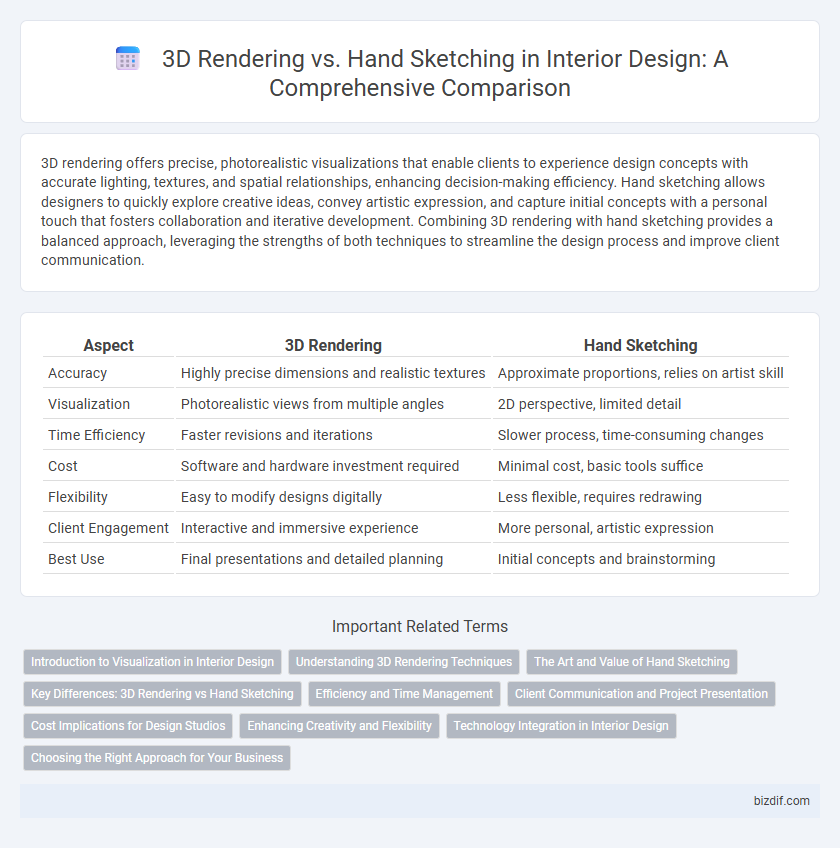3D rendering offers precise, photorealistic visualizations that enable clients to experience design concepts with accurate lighting, textures, and spatial relationships, enhancing decision-making efficiency. Hand sketching allows designers to quickly explore creative ideas, convey artistic expression, and capture initial concepts with a personal touch that fosters collaboration and iterative development. Combining 3D rendering with hand sketching provides a balanced approach, leveraging the strengths of both techniques to streamline the design process and improve client communication.
Table of Comparison
| Aspect | 3D Rendering | Hand Sketching |
|---|---|---|
| Accuracy | Highly precise dimensions and realistic textures | Approximate proportions, relies on artist skill |
| Visualization | Photorealistic views from multiple angles | 2D perspective, limited detail |
| Time Efficiency | Faster revisions and iterations | Slower process, time-consuming changes |
| Cost | Software and hardware investment required | Minimal cost, basic tools suffice |
| Flexibility | Easy to modify designs digitally | Less flexible, requires redrawing |
| Client Engagement | Interactive and immersive experience | More personal, artistic expression |
| Best Use | Final presentations and detailed planning | Initial concepts and brainstorming |
Introduction to Visualization in Interior Design
3D rendering offers highly detailed and photorealistic visualizations that enable interior designers to present accurate spatial concepts and material finishes. Hand sketching, on the other hand, provides a quick and expressive way to communicate initial ideas and design moods with personalized artistic touches. Combining both methods enhances the overall design process by balancing precision and creativity in interior visualization.
Understanding 3D Rendering Techniques
3D rendering techniques in interior design provide realistic and detailed visualizations of spaces, enabling designers to experiment with lighting, textures, and materials virtually. Unlike hand sketching, 3D rendering allows precise adjustments and immersive walkthroughs, enhancing client communication and project accuracy. Mastery of software like Autodesk 3ds Max, SketchUp, or Blender is essential for producing high-quality 3D visualizations that streamline the design process.
The Art and Value of Hand Sketching
Hand sketching in interior design captures the raw creativity and emotional appeal that often gets lost in 3D rendering, offering designers a personal touch and immediate expression of ideas. The tactile nature of pencil on paper allows for spontaneous experimentation with perspectives, shading, and texture, which can communicate the designer's vision more intuitively to clients. This traditional skill enhances the conceptual phase by fostering originality and a deeper connection to the design process, complementing digital tools rather than replacing them.
Key Differences: 3D Rendering vs Hand Sketching
3D rendering in interior design offers precise visualization with photorealistic detail, enabling clients to experience space virtually before construction. Hand sketching emphasizes creativity and conceptual exploration, capturing ideas quickly with a personal touch and artistic expressiveness. While 3D rendering excels in accuracy and immersive presentations, hand sketching remains invaluable for rapid ideation and initial design development.
Efficiency and Time Management
3D rendering significantly enhances efficiency in interior design by enabling rapid visualization and easy modifications, reducing project turnaround time. Hand sketching, while valuable for initial conceptualization, is more time-consuming and less flexible for iterative changes. Utilizing 3D rendering software streamlines workflows and improves time management through precise, realistic representations and quicker client approvals.
Client Communication and Project Presentation
3D rendering offers clients a realistic and immersive visualization of interior designs, enabling clearer communication of spatial layouts, lighting, and materials. Hand sketching provides a more flexible and personal touch, allowing designers to quickly convey conceptual ideas and encourage client input during early project stages. Combining both methods enhances project presentations by balancing detailed accuracy with creative spontaneity, improving client understanding and engagement.
Cost Implications for Design Studios
3D rendering significantly reduces long-term costs for design studios by minimizing the need for physical prototypes and allowing rapid revisions, which lowers labor and material expenses. Hand sketching requires less initial investment in technology but often results in higher costs due to time-consuming iterations and limited client visualization, potentially leading to more frequent design changes. Studios balancing budget constraints and project complexity often adopt 3D rendering to enhance efficiency and cost-effectiveness in the interior design process.
Enhancing Creativity and Flexibility
3D rendering offers unparalleled flexibility by allowing designers to easily modify colors, materials, and layouts in real-time, thereby enhancing creative exploration without the need to start over. Hand sketching fosters intuitive creativity by enabling quick, freeform expression of ideas and spontaneous adjustments, capturing the designer's unique artistic touch. Integrating both methods maximizes creative potential, combining the precision of 3D models with the organic fluidity of sketches to elevate interior design workflows.
Technology Integration in Interior Design
3D rendering leverages advanced software to create highly detailed and realistic visualizations that enhance precision and client presentations in interior design. Hand sketching remains valuable for quick conceptualization and creative exploration, fostering unique stylistic expressions. Integrating digital tools with traditional sketching workflows optimizes design efficiency, allowing seamless transitions from initial ideas to finalized projects.
Choosing the Right Approach for Your Business
3D rendering offers precise visualization and allows for easy modifications, making it ideal for businesses needing detailed presentations and client approvals. Hand sketching provides a personal, artistic touch that can quickly convey initial concepts and inspire creativity during the early design phase. Selecting the right approach depends on project complexity, client preferences, and the desired balance between technical accuracy and expressive creativity.
3D Rendering vs Hand Sketching Infographic

 bizdif.com
bizdif.com